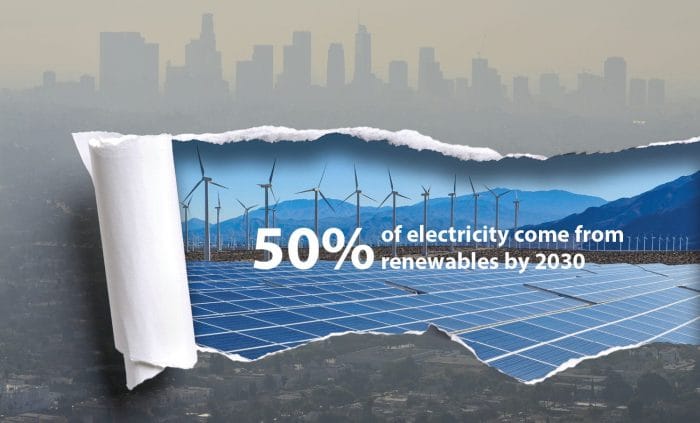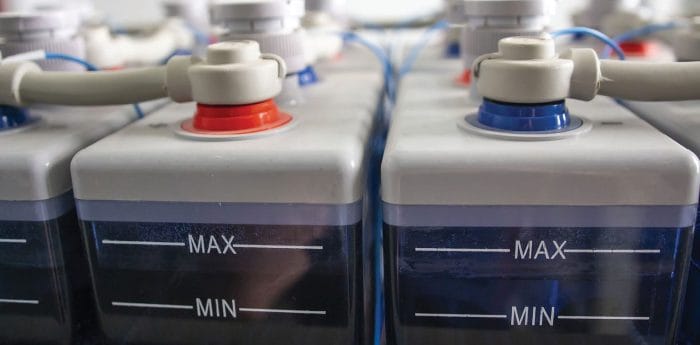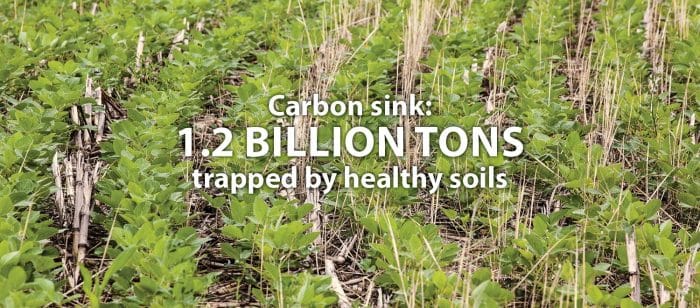This past July, California was a smoke-filled inferno, but it still had some good news about air quality to share. Greenhouse gas (GHG) emissions fell to some 430 million metric tonnes in 2016, the latest year for which data is available. The number is a smidge lower than the 431 million metric tonnes produced in 1990. That means the Golden State met its 2020 GHS emission reduction goals four years early. By 2030, state legislators want to see a drop of 40 percent below 1990 levels.
How is the state hoping to achieve its goals? Through several strategies, some of which impact utilities. First among those approaches is a goal of having 50 percent of electricity come from renewables by 2030.

There’s also a goal of cutting petroleum use in vehicles by 50 percent, an objective strongly tied to electric vehicle adoption. As of October 2017, California had 337,482 electric vehicles on the street, which equals 4.5 percent of the state’s fleet. This makes California the world leader in EV adoption, according to the International Council of Clean Transportation. The number of EV’s on California roads grew 53 percent between 2013 and 2017.
State and federal incentives helped spur such growth, and so did a 74-percent decrease in the cost of batteries compared to 2010 prices, according to a Next10, a San Francisco-based think tank. Mileage ranges that now go as high as the Tesla Model 3’s 300-miles or more on one charge help, too. They decrease range anxiety.
What’s in storage?

Along with encouraging more solar and EVs, California lawmakers have enacted multiple bills to boost battery energy storage deployments. As early as 2013, the state had signed into law a storage mandate requiring the three large investor-owned utilities to jointly procure 1.325 GW by 2020. In 2016, lawmakers passed another bill. As implemented by the California Public Utilities Commission (CPUD), the bill requires the IOUs to add another combined 500 MW of distributed, behind-the-meter storage to their procurement obligations or 166 MW per IOU.
Yet another 2016 bill reflects what California’s Independent System Operator (CAISO) calls the duck curve. That’s the duck-shaped load vs. generation profile formed by mid-day over-production and late-day subsidence of solar generation. In light of this power mismatch, California’s Assembly Bill 33 directs the CPUC to evaluate all types of long-duration bulk energy storage resources, including pumped hydro, for flexible, fast-ramping resources.
A legislative summary of the bill notes that CAISO “has identified energy storage, with its unique ability to both utilize excess electricity generated by renewable energy resources and to quickly inject that electricity back onto the electrical grid to meet ramping and peak demand needs, as a part of the new strategy for efficiently operating the electrical grid in a manner that best protects the environment.”
The dirt on carbon capture
Carbon sequestration is on the list of California emission-cutting strategies, too, but CPUC isn’t involved in one of the state’s more noteworthy approaches. The California Department of Food and Agriculture (CDFA) is leading the way.
Fifty farms are now piloting the state’s Healthy Soils Initiative, which aims to cut greenhouse gas emissions by fostering carbon sequestration via plant growth.
“Currently, some 12 million tons of compostable or mulchable organic waste is sent to California landfills annually, where it generates methane and other public health threats that must be managed or mitigated,” notes the Healthy Soils website. “The Healthy Soils Initiative presents an opportunity to return those organic materials back to the soil, where they can serve as a resource for California’s critical agricultural economy.”
Along with plowing organics back into the land, the Healthy Soils initiative has farmers plant cover crops that surround agricultural crops, reducing the amount of unplanted soil. This helps reduce CO2 emissions in two ways. First, plants themselves remove CO2 from the air in the photosynthesis process. In addition, when plants and roots decompose, stable forms of C02 accumulate in the ground.

According to the Healthy Soils website, 1.2 billion tons of carbon is sequestered by global soils each year. Healthier land holds more water, reduces dust and increases crop yields. “Soil has the transformative power to help us stabilize our changing climate,” says CDFA Secretary Karen Ross. “By capturing greenhouse gas emissions and storing them underground, we improve both the atmosphere and soil.”